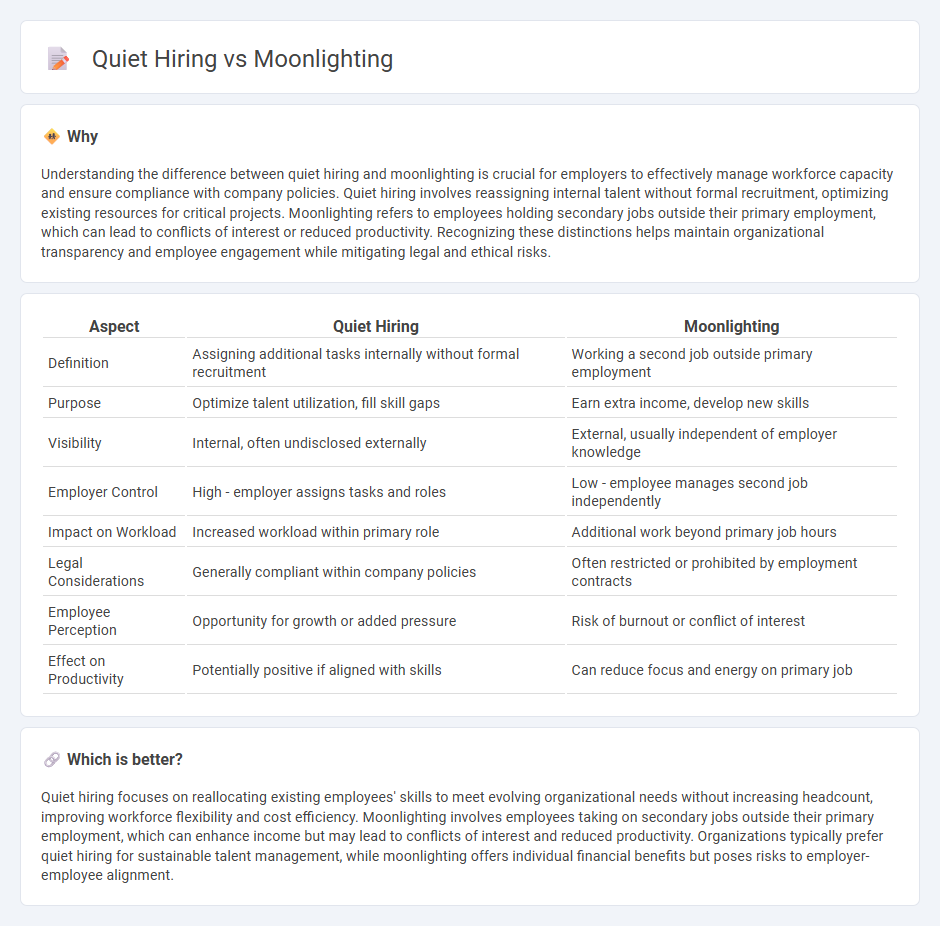
Quiet hiring involves organizations expanding workforce capacity by reassigning existing employees to new roles without formal recruitment, enhancing agility and reducing costs. Moonlighting refers to employees taking on secondary jobs outside their primary employment, often to supplement income but sometimes risking conflicts of interest and burnout. Explore the nuances of quiet hiring and moonlighting to understand their impact on workforce strategies and employee well-being.
Why it is important
Understanding the difference between quiet hiring and moonlighting is crucial for employers to effectively manage workforce capacity and ensure compliance with company policies. Quiet hiring involves reassigning internal talent without formal recruitment, optimizing existing resources for critical projects. Moonlighting refers to employees holding secondary jobs outside their primary employment, which can lead to conflicts of interest or reduced productivity. Recognizing these distinctions helps maintain organizational transparency and employee engagement while mitigating legal and ethical risks.
Comparison Table
| Aspect | Quiet Hiring | Moonlighting |
|---|---|---|
| Definition | Assigning additional tasks internally without formal recruitment | Working a second job outside primary employment |
| Purpose | Optimize talent utilization, fill skill gaps | Earn extra income, develop new skills |
| Visibility | Internal, often undisclosed externally | External, usually independent of employer knowledge |
| Employer Control | High - employer assigns tasks and roles | Low - employee manages second job independently |
| Impact on Workload | Increased workload within primary role | Additional work beyond primary job hours |
| Legal Considerations | Generally compliant within company policies | Often restricted or prohibited by employment contracts |
| Employee Perception | Opportunity for growth or added pressure | Risk of burnout or conflict of interest |
| Effect on Productivity | Potentially positive if aligned with skills | Can reduce focus and energy on primary job |
Which is better?
Quiet hiring focuses on reallocating existing employees' skills to meet evolving organizational needs without increasing headcount, improving workforce flexibility and cost efficiency. Moonlighting involves employees taking on secondary jobs outside their primary employment, which can enhance income but may lead to conflicts of interest and reduced productivity. Organizations typically prefer quiet hiring for sustainable talent management, while moonlighting offers individual financial benefits but poses risks to employer-employee alignment.
Connection
Quiet hiring, where companies discreetly acquire talent without traditional recruitment processes, often intersects with moonlighting as employees take on secondary jobs to leverage newly gained skills or supplement income. Organizations may intentionally engage in quiet hiring to access specialized abilities unavailable within the current workforce while employees moonlight to maximize career growth or financial stability. This dynamic reflects evolving employment trends driven by workforce agility and the gig economy's expansion.
Key Terms
Dual Employment
Dual employment involves an employee holding two jobs simultaneously, often balancing responsibilities to maximize income. Moonlighting refers specifically to working a second job outside regular hours, typically without employer consent, while quiet hiring reallocates internal resources or hires talent discreetly to fill gaps without formal announcements. Explore more to understand how these strategies impact workforce management and compliance.
Talent Acquisition
Moonlighting involves employees taking on secondary jobs outside their primary employment, impacting workforce availability and recruitment strategy in talent acquisition. Quiet hiring refers to the internal redeployment of existing employees to fill skill gaps without formal recruitment, enhancing talent optimization and reducing external hiring costs. Explore more about how these trends reshape talent acquisition and workforce planning.
Workforce Optimization
Moonlighting involves employees taking on secondary jobs outside their primary employment to enhance income or skills, often impacting workforce productivity and engagement. Quiet hiring refers to internal talent optimization by reallocating existing employees to new roles or projects without expanding headcount, thus maximizing workforce efficiency and minimizing recruitment costs. Explore how leveraging these strategies can transform your workforce optimization efforts.
Source and External Links
MOONLIGHTING definition | Cambridge English Dictionary - Moonlighting is the act of working an extra job, often without informing your main employer.
moonlighting | Wex | US Law | LII / Legal Information Institute - Moonlighting refers to holding a second job outside normal working hours, sometimes subject to employer restrictions due to conflicts of interest or job performance concerns.
Moonlighting - Wikipedia - Moonlighting can mean having a side job in addition to primary employment and is also the title of an American 1980s TV series starring Bruce Willis and Cybill Shepherd.
 dowidth.com
dowidth.com